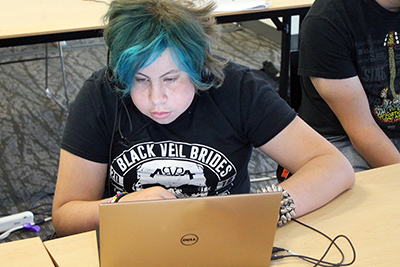DO-IT News October 2018

Volume 26, Issue 4
Below are the articles of the DO-IT News October 2018 newsletter. These articles can also be seen all on one page at the Full Newsletter option.
2018 Trailblazer Award Winners
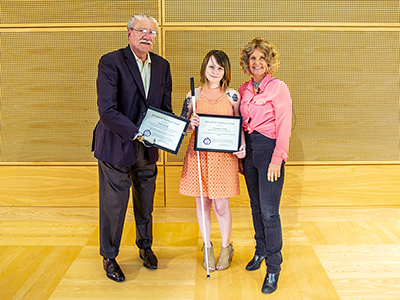
The DO‑IT Trailblazer award highlights DO‑IT community members who forge new pathways that will benefit others. Through their work and accomplishments they have changed the way the world views people with disabilities and have increased the potential of people with disabilities to succeed in college, careers, and community life. Congratulations to this year’s honorees!
Dr. Shiri Azenkot is an assistant professor of information science at the Jacobs Technion‑Cornell Institute at Cornell Tech, Cornell University. Her research interests are in accessibility and interaction on new platforms. Shiri earned her Ph.D. in computer science and engineering at the University of Washington (UW) in 2014. As a student, Shiri was an active participant in DO-IT programs, including the AccessComputing project, which is co-led by the Paul G. Allen School of Computer Science & Engineering and the Information School. She has hosted research interns with a variety of disabilities, presented at a capacity building institute, and spoken in one of our videos. Shiri will be a featured speaker at the Tapia Celebration of Diversity in Computing in 2018.
Courtney Cole, DO-IT Ambassador and ‘13 Scholar, has been a powerful advocate for people with disabilities through her work and personal accomplishments. Courtney joined the Rooted in Rights (RiR) team in 2016 as a creative intern and in September 2017 accepted a position as a creative production assistant. She assists in the production of videos and other media content that cover topics such as the stigma of mental health, violence against people with disabilities, and the inequality that blind students face. The videos she has produced have reached thousands of people around the world. Currently, Courtney studies at Seattle Central College, pursuing an associate of arts degree. Courtney also writes for the RiR blog and other publications. Read Courtney’s RiR blog posts here.
Dr. Shaun Kane is an assistant professor in computer science at the University of Colorado Boulder. He directs the Superhuman Computing Lab, which conducts research on accessible user interfaces, mobile and wearable interactions, and tangible computing. Shaun earned his Ph.D. from UW’s iSchool in 2011. He was a participant in DO-IT programs as a student and is now an AccessComputing partner. In 2015, Shaun was a featured speaker at the Tapia Celebration of Diversity in Computing. He has hosted an AccessComputing intern in his lab, led computer science workshops at the National Federation for the Blind Youth Slam, and mentored other AccessComputing student participants.
John Kemp, a graduate of the Washburn University School of Law, is a renowned disability rights leader who co-founded the American Association of People with Disabilities and has partnered with, worked for, and served as board member, chair and CEO of leading disability organizations. He is the President and Chief Executive of the Viscardi Center (formerly known as Abilities!), a network of non-profit organizations that educate, employ, and empower people with disabilities. For decades, Kemp has been a role model and an ally of DO-IT and other organizations that serve to create a more inclusive world. His many awards include the Dole Leadership Prize from the Robert J. Dole Institute of Politics at the University of Kansas, joining a group of international recipients that includes Nelson Mandela. He has mentored DO-IT Scholars and served as the featured speaker for Summer Study 2018.
To read about DO-IT Trailblazers from past years, visit our awards page.
Summer Study: What Do Phase I Scholars Do?
DO‑IT Phase I Scholars participate in a two-week, live-in Summer Study session on the UW Seattle campus. They learn about college life; explore the Internet; interact with peers, staff, and mentors; and have fun. The DO‑IT Scholars program started in 1993 as an experimental project for teens with disabilities nationwide. It is currently open to Washington State teens and is supported by the State of Washington, the Boeing Company, the Microsoft Corporation, and the National Oceanic and Atmospheric Administration.
The Life of Living in a Dorm
Have you ever wondered what life is like living in a dorm? There are many pros and cons to this style of living on college campus.
Pro: Hang out with your friends all the time without parents telling you what to do!
Con: You may miss your family, miss your room and bed at home, and feel like your space is crowded when sharing a small room with a roommate.
Pro: With certain types of meal plans, you can qualify for an all you can eat buffet!
Con: You have to figure out what you want to eat or can feel sick if you eat too much junk food.
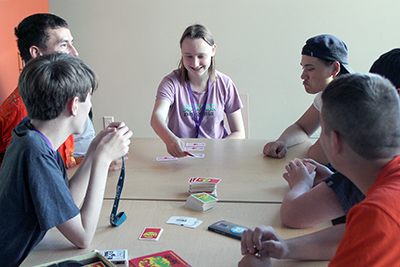
Pro: Stay up all night with your friends. You’re never bored because you’re so busy!
Con: Sitting through long lectures and a day full of activities without enough sleep can make you very tired.
Pro: You have more independence and can ask for help as needed, with staff always available or on call!
Con: Accommodations need to be requested in advance and may take time to be granted. You should plan in advance before moving into your dorm for what you need. While all people should have access and be treated fair and equal, people with disabilities often need to advocate for themselves when they need something.
Intersectionality and Discrimination
If you look up people with disabilities, chances are you’ll find a picture of a straight white person who completely fits gender norms. Modern society often pushes the belief that one person can only belong to one minority group. Unlike these pictures would have you believe, the disabled community is extremely diverse.
Like any minority, we aren’t made up of one specific type of people, and our issues can go far beyond a lack of access and/or ableism. Because our community is so diverse, lots of us have to deal with intersecting oppressions.
Many people in the disabled community are also LGBT+ (lesbian, gay, bisexual, transgender, plus) and/or people of color. Often, they can find their voices minimized and unheard, or that people only focus on their disability, rather than other aspects of their identity. For LGBT+ people, this can reinforce the narrow view of what constitutes as “normal” gender identity, and often leaves them outside of the conversations about them and without representation either an LGBT+ person or a person with a disability.
For disabled people of color, especially those who are LGBT+, they find they often face discrimination for all sides of their identity and become marginalized because they aren’t prototypical for any specific identity. For example, even though three black LGBT+ women started the Black Lives Matter movement, most media coverage focuses on black men (The Conversation, 2016).
Societal expectations and stereotypes can also influence encounters with our judicial system, represented through police encounters and the prison system. For example, as seen in the statistics, police encounters are more likely to be deadly for both people of color and people with disabilities compared to people with majority identities (Mapping police violence, 2018; Hause & Melber, 2016).
For someone with both of these identities, it raises the likelihood even higher. Many mental disabilities can cause a person to think differently, misunderstand, communicate ineffectively, or not be able to control their thoughts or statements. Paired with assumptions and stereotypes based on race, disabled people of color have higher rates of being shot, imprisoned, and injured by police due to a lack of understanding (Davis, 2009; Mapping police violence, 2018; Oberholtzer, 2017; O’Hara, 2016).
Furthermore, people with disabilities, as well as those of other identities, can often be sentenced to jail or prison at higher rates, due to a lack of ability to understand the legal process, money to hire a better lawyer, and stereotypes within the system and then have higher likelihood of mistreatment in prison (Davis, 2009; Oberholtzer, 2017). As Oberholtzer states, “Less than half of jails are equipped to offer mental health treatment. Just 21% have programs to support mentally ill people upon release.” Those who identify as LGBT+ also report higher rates of abuse (Amnesty International, 2001).
The way LGBT+ disabled people of color are treated is extremely telling of how the police and prison systems are set up to only understand the “norm,” especially here in America. Racism, ableism, and sexism are prevalent in society, and our judicial system.
This is why we need to combat discrimination across all minorities, particularly where intersections lie. Society is often less safe and welcoming for a person with a disability, a person of color, and those who are LGBT+.
References:
Amnesty International. (2001). Crimes of hate, conspiracy of silence: torture and ill-treatment based on sexual identity. Oxford: The Alden Press.
Davis, L. A. (2009). People with intellectual disability in the criminal justice system: Victims and suspects. The Arc. Retrieved from https://www.dcjs.virginia.gov/sites/dcjs.virginia.gov/files/part_12_vict...
Hause, M. & Melber, A. (2016). Half of people killed by police have a disability: Report. NBC News. Retrieved from https://nbcnews.to/2yEtVVO
Mapping police violence. (2018). Retrieved from https://mappingpoliceviolence.org/
O’Hara, M. (2016). Up to half of people killed by US police are disabled. The Guardian. Retrieved from http://bit.ly/2yifFT9
Oberholtzer, E. (2017). Police, courts, jails, and prisons all fail disabled people. Prison Policy Initiative. Retrieved from https://www.prisonpolicy.org/blog/2017/08/23/disability/
The Conversation (2016). Intersectionality: How gender interacts with other social identities to shape bias. Retrieved from http://bit.ly/2RPo2Op
Disability and Employment
At a 3.9% rate of unemployment, the United States is on track for the lowest unemployment rates since World War I. You may see this as good news, but this statistic overlooks one of the largest minorities in the United States— the disabled. Of disabled workers that are of working age, over 35% are unemployed. This statistic is in stark contrast workers without disabilities (3.9%). You may ask what has caused this huge divide in employment rates, and the answer isn’t as simple as you might think.
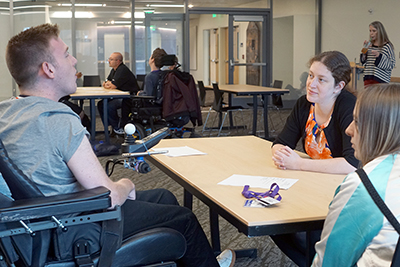
A common factor that causes this divide is disability stigma and ableism. People with disabilities are often thought to need extra help or be less of a hard worker than an able-bodied employee. This has been proven false in many studies; they are often harder workers and need the same level of help as people without disabilities. Even so, some small businesses see a potential barrier in hiring disabled employees due to the costs associated with accommodations. The cost of accommodations is often 500 dollars.
Employment is one of the most important parts of adult life. The disabled community and allies fight against the stigma that is attached with “disability” to provide job opportunities for people with disabilities. By being more open about disability, we can work together to fight ableism.
How Ableism Affects People with Disabilities
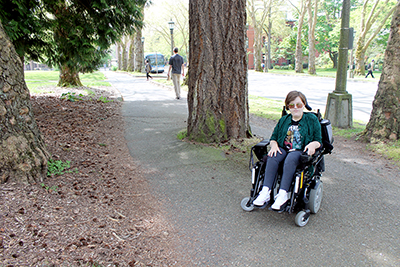
Ableism is a form of discrimination against people with disabilities, being seen as lesser or having their access controlled based on their abilities. In 2015, then presidential candidate Donald Trump mocked a reporter with a disability at a rally by pretending to suffer from muscle spasms. Ableism is still prominent in society. DO-IT Ambassadors and Scholars were eager to share their experiences in this regard.
“I have experienced ableism on the UW campus because of all the stairs,” said Lindsey, who uses a power chair. She also said the sidewalks are in bad shape, making traveling take longer and planning how to get around campus a challenge.
Lindsey and Vanessa, a fellow wheelchair user, also have had negative experiences with societal expectations. Waiters in restaurants have asked their parents or friends what they want. “I have experienced ableism because of the way people look at me. They look at me like a baby when I’m an adult,” said Vanessa.
Izzy has dyslexia, a learning disability that makes it hard to read, write, and spell. “In 3rd grade I asked this kid how to spell a word,” Izzy said, “and he wouldn’t spell it for me. He called me an idiot.” This can be a common misconception, as disabilities like attention deficit hyperactivity disorder, dyslexia, and dysgraphia can be confused with general ignorance.
Takashi, who has impaired vision, said his disability is usually invisible, but when it is noticed or mentioned, he is told he is an inspiration. Some people are inspired by seeing people with disabilities simply their normal life. Often the bar is set so low for people with disabilities, just getting up in the morning is celebrated as inspirational.
Cheyann, who is blind, uses a cane and often asks people for directions. “People see me as fragile,” she said. “I was walking in the pool and my hands were out to protect me. A man ran out, screaming at me, trying to grab my hands,” she described an experience that stood out to her. “It just annoyed me that people assume I’m doing something wrong.”
People with disabilities are often not taken seriously or treated as equals to “normal” people. While it is usually a subconscious bias, it is obvious there is a divide between disabled and non-disabled people. The media continues to propagate a narrative that people with disabilities are to be pitied or inspirational rather than just normal human beings.
The more we refuse to recognize the potential of disabled people, the more everyday people become ignorant of reality. Change starts with everyone working together. Ableism is defeated by actually talking to people with disabilities and realizing they are people first.
Summer Study as a Whole
Dillen: The DO-IT Summer Study program allows students with disabilities to interact within a community. As someone who is generally outgoing, my concerns were not so much about socializing, but rather about being in a dorm-style environment as I had not done that before. I was excited to meet those with similar disabilities—due to my cerebral palsy, I’ve experienced things such as spinal fusion surgery that cannot be fully understood by my classmates at school.
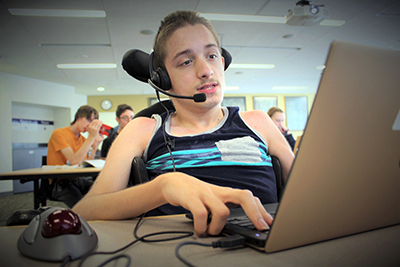
At Summer Study, my favorite day was spent at Microsoft, as it relates to computer science, which I want to major in. I found it interesting to hear about ways people can leverage their disability to improve other sectors they have a passion for. I also enjoyed classroom-based activities, which covered both disability-related and non-disability-related topics.
In the evenings at DO-IT, we engaged in fun activities, such as playing board games and socializing. One thing that makes DO‑IT unique is that many staff and interns have disabilities, which promotes an open environment for Scholars to express concerns about disability and non-disability topics. Overall Summer Study was a great experience.
Dean: When I first arrived at DO-IT Summer Study 2018, I was astronomically anxious. It was a new situation, full of people who I’d never met before. Before this, I’d never been this far away from home for more than a day or two. Because of my disability (autism spectrum disorder), I have a hard time adapting to new situations and meeting new people, so that made the icebreaker at the barbecue dinner on the first night a bit of a challenge. I was worried that my time here wouldn’t get any better; that I’d feel this uncomfortable and homesick the entire time. And, as ridiculous as it sounds, I was a little bit afraid that nobody would really like me here. Thankfully, all of these worries were eliminated over the next day or two, and I began to actually enjoy my time here.
We ended up taking part in some fantastic activities. We went on field trips, such as to the KUOW radio station, which, as an avid music enthusiast, I really enjoyed. I got to look at the equipment in the recording rooms and learned some tips on interviewing people. I loved this visit, especially because I got to experience it with my newfound friends.
We also learned important skills for college and beyond during Summer Study. For example, I knew almost nothing about the difference between getting accommodations in high school versus getting accommodations in college. We even got to practice informing real professors about our disabilities and accommodations in a real-life situation.
It was also an invaluable time to practice our independence and self-advocacy skills. At DO-IT, you’re expected to act on your own and ask for help if you need it. The environment here at DO-IT is very supportive, and there’s an entire network of friends behind you. Everyone is willing to help you; all you gotta do is ask!
Accessibility Within Public Transportation
The Merriam-Webster dictionary describes being disabled as being “impaired or limited by a physical, mental, cognitive, or developmental condition.” Most people with disabilities aren’t able to complete certain tasks as they are set up in modern society—for example, boarding a bus or riding a bicycle.
Riding a standard bus can be challenging if the bus has not provided accessible services. Many buses kneel to lower the door closer to a curb, or have retractable ramps or lifts that bring the wheelchair into the vehicle. After boarding the bus, there should be spots for wheelchairs to be secured inside.
Buses are not the only transportation option. Most commercial airline provide transfer aisle chairs, waive luggage fees, and allow service animals. Airline employees are also taught skills in talking and interacting with people with disabilities. Some airlines even have programs specialized for people on the autism spectrum or with anxiety-based disabilities.
For ground transportation, there are many accessible taxi options, including Uber’s Accessibility feature, Yellow Taxi’s ramped vans, and Dial-a-Ride Transportation (DART). Google Maps also offers accessibility options, which avoid obstacles and hills. Even something as simple as bicycling has become possible for most, with hand-powered bikes and other accessible options.
Modern technology has progressed to accommodate more people. While some areas may remain inaccessible, society is constantly improving to be more accepting and inclusive.
How People Become Friends at DO-IT
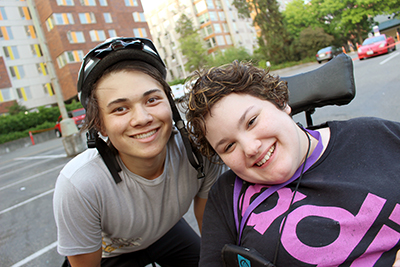
Maribel: The DO-IT Summer Study program is for people with disabilities like mine. For me, Summer Study isn’t just about making friends or doing projects; it is about taking in your accomplishments and knowing that you do not have to be afraid of going out into the world and achieving your dreams!
Sandra: When I first came to DO-IT, I didn’t know anyone, and I was scared that I wouldn’t fit in. I had also not been around a lot of people with disabilities before, so I didn’t know the right things to say or do. However, I quickly learned by talking to people that we all have different abilities. This helped me become friends with others.
When I first met Maribel, I didn’t know how to interact with her. But once I took the time to get to know her, I realized she is great! This made me realize you shouldn’t judge people by your first impression. Give yourself the opportunity to know the person. People with disabilities get judged all the time, which isn’t fair. There are great people in the world that you may not be giving yourself a chance to meet.
Summer Study: What Do Phase II Scholars Do?
Phase II Scholars return to the UW Seattle campus for their second Summer Study. They meet the Phase I Scholars, learn about college life and career preparation, and participate in a one-week workshop with postsecondary instructors.
Neurobiology
Phase II Scholars Anna, Jordan, Tycho, Myles, and Alex attended a neurobiology workshop led by professor Martha Bosma and UW students Hiro, Kelly, Jesse, Kirsten, and Chris. The Interns who attended the workshop were Teresa, Jarrod, and Cameron. In this workshop, there were two separate projects: one was the stimulation of a cockroach leg and the other was the dissection and physiological experimentation of embryonic mouse hearts.
Tycho, Jordan, and Anna worked in the cockroach lab. Hiro taught them about the basic structure of a neuron, the various responses, and the concept of action potentials. He covered depolarization and polarization and when it changes. The Scholars tested electrical stimulation with and against the grain of the cockroach leg, listening for variations in sound and recording the differences in variables, including the positioning of the legs and whether music was being played. They discovered that the cockroach leg was more active when lively music was played compared to slower music. They also concluded that more electrical feedback occurs when the leg was stimulated against the grain. Scholar Anna reported that her favorite thing she learned was about pain sensation and how neurons can rapidly wear out (known as “accommodation”).
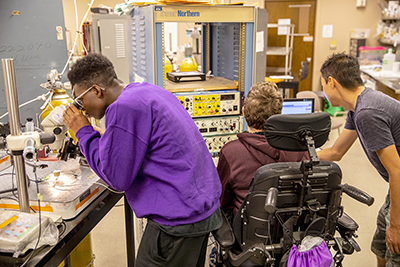
In the second group, Myles and Alex began the embryonic mouse heart lab led by Martha Bosma. Mouse embryo hearts are about the size of a pin on a needle. On day one, the hearts were beating slowly because the mice embryos were at a less active stage. On day two we added nicotine, which made the heart start to beat sporadically. The left atrium beat faster than the rest of the heart, causing an irregular rhythm. The heart ended up overdosing on nicotine and stopped beating, which was not the intended result. We learned more about hearts, as well as learned how to read and review scholarly articles.
Overall the neurobiology lab was a great learning experience and an informative way to learn how electricity works within our bodies. We would like to thank biology professor Martha Bosma for supporting us and donating her time. We would also like to acknowledge the many undergraduate and graduate students that spent their mornings serving us as well. Without these people, our experience would not have been the same!
Let’s Do Video! Video Storytelling with Rooted in Rights
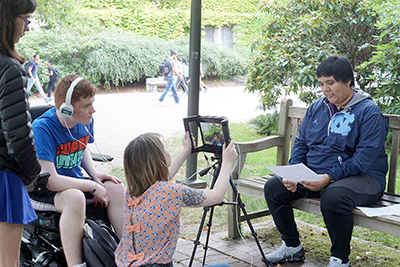
Have you ever wanted to tell a story or create a video? If so, you would love the Phase II workshop Let’s Do Video! Video Storytelling with Rooted in Rights. Phase II Scholars PJ, Hayley, Jono, Camilo, and Jane learned how to create unique videos about disability representation and accessibility.
The Scholars were guided and directed by an amazing group of instructors: Courtney Cole (2013 Scholar), Vanessa Link (2014 Scholar), Jordan Melograna, Rachael Miyazaki, Vilissa Thompson, and Anna Zivartis. Throughout the week, the Scholars wrote scripts, created B-role, chose music, edited footage, created captions, and created audio descriptions. The Scholars created fantastic videos while learning important skills they can use in the future. View the two videos produced on Facebook on the Rooted in Rights page!
New Article on Broadening Participation at Engineering Research Centers
Engineering Research Centers (ERCs) are at the cutting edge of new technology and scientific discoveries. Without a diverse range of people, ERCs can’t reach their full potential. DO-IT and the Center for Neurotechnology (CNT) have teamed up in AccessERC to make sure the CNT is as diverse and inclusive as possible. Assistant Diversity Director Scott Bellman, Diversity Director Sheryl Burgstahler, and CNT leader Eric Chudler published an article to help promote inclusivity in other ERCs.
Their article, “Broadening Participation by Including More Individuals With Disabilities in STEM: Promising Practices From an Engineering Research Center” was published by American Behavioral Scientist. Read the full article and see more resources for creating an fully inclusive ERC.
AccessCSforAll Professional Development Workshop for Teachers of Blind and Visually Impaired Students
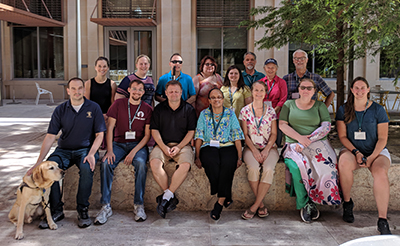
AccessCSforAll held its first professional development workshop for teachers of blind and visually impaired students at the University of Texas, Austin, for one week in July 2018. The workshop was led by AccessCSforAll principal investigators Richard Ladner and Andreas Stefik and assisted by William Allee, Quorum programming language developer, and Sean Mealin, Ph.D. student at North Carolina State University and AccessComputing Team member. Eleven teachers from ten different states and Puerto Rico participated in the workshop that focused on the accessible Computer Science Principles (CSP), which is based on the Code.org CSP curriculum and the Quorum Language lessons. Activities in the workshop were modeled after the activities at Code.org’s TeacherCon professional development workshop held in Atlanta in June 2018 that Ladner attended. Activities at the AccessCSforAll workshop included an overview of CSP, lesson preparation and teaching by participants, Quorum programming language overview and lessons, and critiques of the latest accessible CSP curriculum draft developed by the AccessCSforAll team at the University of Nevada, Las Vegas. The critique included suggestions to make the curriculum, both plugged and unplugged activities, more accessible for blind and visually impaired students.
Three of the teachers who came from mainstream schools did not have experience with blind students, but were expecting them in their classes this coming year. One session included advice by the experienced teachers of blind students on proper etiquette when interacting with blind people. There will be additional professional development, done remotely, with these teachers during the academic year. In 2019, AccessCSforAll will hold additional professional development workshops for teachers of deaf students and teachers of learning disabled students.
My Study Abroad in Italy
I studied abroad in Italy during fall of 2017 for ten weeks. Being a medical anthropology and global health major, I participated in the UW Study Abroad program “Anthropology Rome: The Culture and Politics of Food in Italy.” I was initially interested in the program because food was a topic I had not studied much in my classes at UW, and I was interested in learning how culture, politics, and food were intersected and in what ways food affects population health.
Being a Deaf person, I use accommodations such as sign language interpreters, note takers, and captions on videos. Travelling to a foreign country can be difficult when having accommodations. I had to work with the Disability Resources for Students (DRS) center on campus starting six months before I left the States. We decided it would be best if an interpreter met me in Rome and stayed with the group for the duration of the program. I also got note taking and captioned videos. For my apartment, I had strobe lights to alert me if there was a fire in the building. It was not difficult to get accommodations; it just took a lot of communication and coordination between several people to make it all happen.
I stayed in an apartment with four roommates in Trastevere, a part of Rome that is known to be very lively and busy. There would be bands, fire breathers, circus acts, dancers, magicians, and other one-of-a-kind acts. I would often stop and watch because the acts were always complex and creative, as well as easy to follow along. There wasn’t any language barrier to overcome; it was universal communication.
While in Rome, we had classes every day for the first four weeks about Italian gastronomy, global food politics, and alternative food economies. We had an intensive language course where we learned conversational Italian. We also visited a lot of markets such as Campo de Fiori, San Cosimato, Zolle, Testaccio, and so many more. Visiting these markets was essential in our application of concepts learned in class. For example, we learned that food has become much more industrialized and built to create quantity over quality. This has caused widespread hunger, malnutrition, and the loss of food democracy. Italian farmers are working together to promote change in the food industry by reverting to older, more healthy and cheaper farming practices.
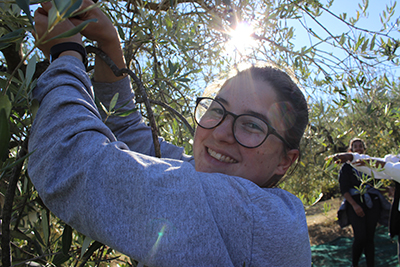
For the next four weeks we travelled to different farms around Italy, learning farm operations and how having smaller farms improves population health. We stayed on Suzie’s Yard in Cetona for 10 days picking olives and learning how to make olive oil. We also cooked a lot, learning a lot of traditional Italian recipes such as Minestrone soup and pasta sauces, as well as how to make fresh pasta. We then stayed at Casa Caponetti in Tuscania. At this farm, we learned about planting crops, animal husbandry, and Olive Oil gastronomy. We picked olives, planted garlic, and learned new recipes such as Tuscan bean soup, pumpkin soup, and focaccia. Both of these farms taught the importance of producing pesticide- and chemical-free crops.
One of the best parts about studying abroad in Italy was, of course, the food! I ate pizza, pasta, bread, soup, cheese, salami, gelato, tiramisu, etc. One might think that all of this food is really heavy and unhealthy, but in actuality, pretty much all food in Italy is produced with fresh ingredients. Most food is not processed and is made with the freshest ingredients possible, which means people are not ingesting unnecessary chemicals. This makes it so that even the big bowl of pasta with greasy red sauce is likely healthier than the same dish found in the U.S.
In summary, I learned a lot about food, culture, farming, natural eating, and travelling. It was a trip of a lifetime. I loved having the chance to travel independently, meet new friends, learn how to speak some Italian, meeting Italians, and so much more. One thing I learned about myself was that I would love to be a farmer. I’ve always had a garden in my backyard and every summer my family and I grow tomatoes, beans, peas, zucchini, cucumbers, and other various vegetables. I’ve decided that one day I want to own a bigger piece of property somewhere, raise animals, grow crops, and farm. I encourage anyone to participate in urban farming and produce fruits and vegetables. After all, farming is simple, all it takes is some soil, seeds, and water.
Third-Year DO-IT Scholars Offer Advice to New Participants
Each summer, the DO-IT Scholars program hosts 45 high school and college students with disabilities on the UW campus, where they learn about technology, self-advocacy, college-preparation, and disability culture. During the 2018 Summer Study, third-year students offered advice to incoming Scholars. Some highlights include the following:
- “We are all in the same boat. My visual impairment is different from a mobility impairment, but there’s a reason that we are in this program together. We all have a disability, and we should stick together to build a better community.”
- “Always ask questions. There’s no such thing as a dumb question. And if you’re not sure about something, give it a try.”
- “I struggled a lot and I wouldn’t ask for help, because I was determined to do it myself. I thought asking for help would be embarrassing, but it wasn’t. Feel comfortable asking for help.”
-
“Try the different types of technology that you received from DO-IT and those you will see during Summer Study. Before Summer Study two years ago, I had no idea about Audio Notetaker or the PDF-to-Word converter service, both of which make things more accessible for me.”
- “It’s normal to miss home. At first, I missed home a lot, and there were moments where I would be sad. But there were also points where I was thinking ‘I can’t wait to show them this! This is so cool.’ So, I learned to look at the positive and look at your glass as half full.”
- “Be kind. Nobody is just like you, so be open to getting to know new people and try new perspectives, because you might learn something new or find a more efficient method.”
Visit our site for more information about the Scholars program.
Ed-ICT International Network Update
Through the Ed-ICT International Network we are exploring the ways that information and communication technologies (ICT) affect students with disabilities in postsecondary education experience.
In its first two years of operation, the Network has begun
- synthesizing and comparing the research evidence across the five countries regarding the relationship between students with disabilities, ICTs and post-compulsory education;
- constructing theoretical explanations for why ICTs have not yet brought about the reductions in discrimination, disadvantage, and exclusion that were predicted when equality and discrimination related laws were published; and
- providing new perspectives about potential future solutions regarding how post-compulsory education institutions can better use ICTs to remove the ongoing problems of disadvantage and exclusion of students with disabilities.
For more information, consult the project website.
IDEAS Grant
We are excited to announce the Excellence, Diversity, and Inclusion: Individuals with Disabilities Engaging for Academic Success (IDEAS) project. The IDEAS project will be coordinated by the DO-IT Center at the University of Washington (UW). Funding for this project was won through UW’s Diversity and Inclusion Seed Grants program. These grants support projects for institutional transformation across the UW’s tri-campus community that align with the goals of the 2017-2021 UW Diversity Blueprint.
The DO-IT IDEAS project will create a peer‑mentoring cohort of students with disabilities from all three UW campuses. It will host monthly workshops, facilitate online activities, provide mentoring, and generate/disseminate ideas for faculty and staff about supporting and welcoming students with disabilities, realizing that many of these students also represent other underrepresented groups. The project will also engage UW stakeholders such as faculty and staff, the Career and Internships Center, Disability Resources for Students, student groups, and the D Center.
The monthly networking events will allow students to talk with each other about successes and struggles, as well as to share advice about disability-specific issues and resources on campus. Students in the cohort will be added to an electronic community where they can stay connected throughout the school year by asking questions, accessing resources, and sharing relevant information. IDEAS project staff will facilitate discussions within the community and promote networking and leadership events.
This project will help achieve the UW Diversity Blueprint through its engagement with students with disabilities, who are sometimes excluded from diversity initiatives. It will foster a welcoming environment to retain these students. The project will facilitate a tri-campus cohort of students to explore and share the diversity needs of students with disabilities at the UW. This will create an impact that extends to the entire campus community.
About DO-IT
DO-IT (Disabilities, Opportunities, Internetworking, and Technology) serves to increase the successful participation of individuals with disabilities in challenging academic programs and careers, such as those in science, engineering, mathematics, and technology. Primary funding for DO-IT is provided by the National Science Foundation, the State of Washington, and the U.S. Department of Education.
For further information, to be placed on the DO-IT mailing list, request this newsletter or other materials in an alternate format, or make comments or suggestions about DO-IT publications or web pages, contact us at
DO-IT
University of Washington
Box 354842
Seattle, WA 98195-4842
doit@uw.edu
www.uw.edu/doit/
206-685-DOIT (3648) (voice/TTY)
888-972-DOIT (3648) (toll free voice/TTY)
509-328-9331 (voice/TTY) Spokane
206-221-4171 (fax)
Founder and Director: Sheryl Burgstahler, Ph.D.
Program Manager: Scott Bellman
